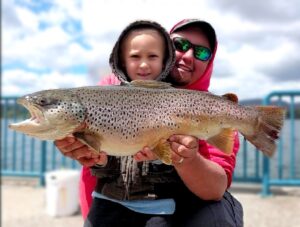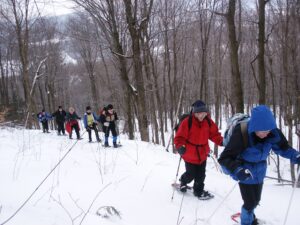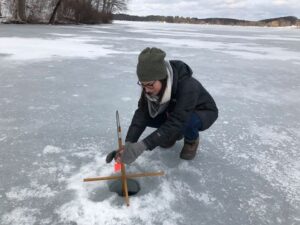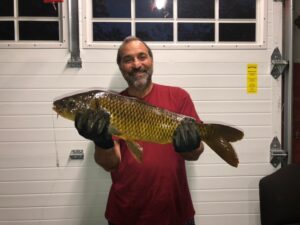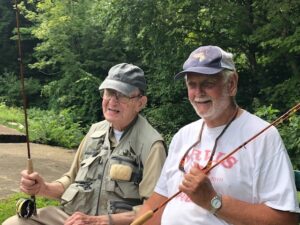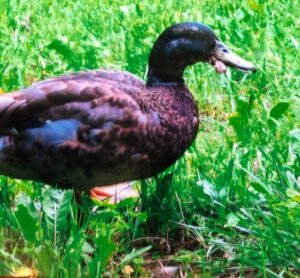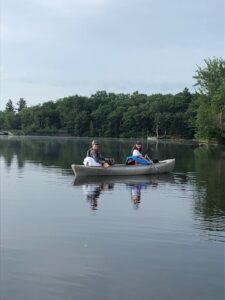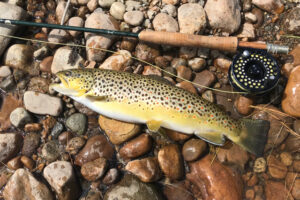Each year, MassWildlife recognizes anglers who catch exceptional freshwater fish in waters open to the public.
Joshua Christman of Pittsfield, has been named 2021 Catch & Keep Angler of the Year by MassWildlife. This is his third win in the last five years, having won that award in 2016, 2020 and 2021. Last year’s award was for catching the following gold pin fish in the Freshwater Sportfishing Awards Program: A 29 lbs. 13 oz carp out of Laurel Lake in Lee, and a 7 lbs. 8 oz largemouth bass out of Onota Lake in Pittsfield. I’m sure he was awarded many bronze pins also.
In the Youth Catch & Keep Category, Philip Prieur of South Hamilton was named Angler of the Year. He caught the following gold pin fish: A 6 lbs. 6 oz bowfin out of the Taunton River in Taunton, a 6 lbs. 12 oz channel catfish out of the Westfield River in Agawam, a 2 lbs. crappie out of the Merrimack River in Lawrence, a 6 lbs. 4 oz white catfish out of the Charles River in Cambridge and a 3 lbs. 10 oz shad also out of the Merrimack River.
The Catch & Keep Angler of the Year Award is given to the person who weighs in the largest number of species that meet the minimum weight requirements for the previous calendar year.
I should mention that Gabriel Christman (Joshua’s son) caught the following gold pin fish in the Youth Catch & Keep Category: A 3 lbs. brook trout, a 10 lbs. brown trout, a 7 lbs. 13 oz largemouth bass and a 4 lbs. 6 oz smallmouth bass all out of Onota Lake in Pittsfield. He also caught a 14 oz sunfish out of Richmond Pond in Pittsfield and a 1 lbs. 11 oz white perch out of Pontoosuc Lake in Lanesborough.
In the Catch & Release Category, David Desimone of Amherst caught the following gold pin fish: A 32 inch bowfin out of Oxbow Pond in Easthampton, a 20.75 inch brook trout out of the Swift River in Belchertown, a 28 inch brown trout out of the Deerfield River in Charlemont, a 27.25 inch rainbow trout out of the Swift River in Belchertown, a 25.50 inch tiger trout out of Ashfield Pond in Ashfield, and a 24 inch white catfish out of the Charles River in Cambridge.
The Catch & Release Angler of the Year Award is awarded to the person who submits the largest number of species that meet the minimum length requirements for the previous calendar year. Nearly 1,000 pins are awarded annually.
Other gold pin fish that were caught out of Berkshire waters last year were:
In the Adult Catch & Keep Category: A 15 lbs. 13 oz brown trout caught out of Stockbridge Bowl by James Pollard of Hinsdale and a 23 lbs. 8 oz northern pike caught out of Onota Lake by Jeffrey Klammer of Adams,
In the Youth Catch & Keep category gold pins were awarded for the following Berkshire catches: 2 lbs. bullhead caught out of Otis Reservoir by Colten Andras of Westfield, a 5 lbs. 10 oz chain pickerel caught out of Stockbridge Bowl by Cooper Shepardson of Lenoxdale and a 16 lbs.5 oz northern pike caught out of Pontoosuc Lake by Caesen Kendall of Pittsfield.
In the Catch & Release Category, a gold pin was awarded for a 45.50 inch northern pike caught out of Onota Lake by Craig Strong of Springfield.
Angler of the Year recipients and gold pin winners are honored each year at a MassWildlife awards event where they will get a gold pin and a plaque. The date and location TBA.
I have only listed the names of the gold pin winners. There is another pin awarded and that is the bronze pin. If you submit a fish that meets the minimum weight or minimum length requirements for an eligible species, you’ll get a bronze pin from MassWildlife for that species.
There were 9 new state records all in the Catch & Release Category: DeSimone’s previously mentioned 32 inch bowfin, 20.75 inch brook trout, 27.25 inch rainbow trout, and a 25.50 inch tiger trout; a 21.50 inch bullhead caught out of Stiles Pond in Boxford by Roger Aziz, Jr. of Methuen, a 44 inch carp caught out of the Connecticut River in South Hadley by Kenneth Langdon of South Deerfield, Craig Strong’s 45.50 inch northern pike out of Onota Lake, a 13 inch sunfish caught out of Wright’s Reservoir in Westminister by Griffin Sabolevski of Winchendon, and a 40.40 inch tiger muskellunge caught out of Spy Pond in Arlington by Jacoby Chalmers of Arlington.
Congratulations to all the 2021 winners!
Ice fishing derbies
Next Saturday, February 26, the Ashfield Rod & Gun Club has scheduled an Ice Fishing Derby which will run from 8:00 am to noon. Registration will take place at the Ashfield Lake House Beach. Participants can park at either the Ashfield Lake House or the Town Beach. Bring your own equipment, but some holes will be drilled. A warming fire and refreshments will be provided. Awards will take place at 12:00 noon. For more information, contact ARGC president Jack Shea at 413 522 6150.
The Tom Wren Memorial Derby is scheduled for February 26 from 6:00 am to 3:00 pm on Pontoosuc Lake. Sign in at the camper near the Narragansett Park. Entry fee is $10, all cash paid out 1st, 2nd and 3rd heaviest fish. There may be something for kids, too.
The 38th Annual Springfield Sportsmen’s Show
Billed as the largest pure hunting and fishing show in the Northeast, it is filled with hundreds of booths, seminars and action areas. The show is filled with an outdoorsman’s dream of fishing and hunting gear, outfitters, charter boats and adventure destinations, along with great deals on fishing boats, ATV’s and UTV’s. There will be great attractions and displays such as The Northeast Big Buck Club, Trout Pond, and more.
The Outdoor Sports Expo Group brings together just the right mix of hunting and fishing celebrities, industry experts, and entertainment features to produce a sporting and outdoor show that is educational, entertaining, and fun.
Each year, the show draws exhibitors from all over the Northeast who are eager to present their products and services to outdoor sporting enthusiasts throughout the greater New England area. Returning and all new fishing tackle vendors will exhibit and sell fishing reels and rods, hard and soft plastic baits, fishing kayaks with accessories, boats of all types, etc.
The show take place at the Eastern States Exposition (Big E) 1305 Memorial Ave., West Springfield, MA on February 25 through 27. The show hours are Friday from noon to 8 PM, Saturday 9 AM to 7 PM and Sunday 10 AM to 5 PM. Admission: Adults – $15, kids 6 to 12 – $5 and under 6 free.
MassWildlife winter chores
In the February Berkshire County League of Sportsmen meeting, DFW Western District Supervisor Andrew Madden reported the following less newsworthy but important projects were completed:
- Wood Duck Boxes– The Western District has completed its winter wood duck box checks. They checked 130 boxes. Hooded Mergansers attempted nests in 47 of the boxes, most of which were successful to hatch. Wood Ducks used 9 boxes, most of which were successful to hatch. Some 41 boxes were unusable because of damage from wind, weather, flooding, age or other damage. The remaining boxes (33) were not used by any duck species.
- Apple Orchard Restoration Efforts – We are fortunate in the Western District to have extensive remnant apple orchards. Each winter they spend time recovering some of these sites to increase soft mast for wildlife. So far through January they have daylighted and pruned more than 40 apple trees on the Chalet Wildlife Management Area in the towns of Cheshire, Dalton, Lanesborough and Windsor.
Endangered Wildlife Conservation
MassWildlife reminds us that tax season is here, meaning it’s a great time to help keep Massachusetts wild. One easy way to help endangered animals and plants is by donating on your state tax return. Simply fill in the amount you would like to donate on Line 33A for Endangered Wildlife Conservation.
Such donations go to the Natural Heritage and Endangered Species Fund, a fund dedicated specifically to the conservation of rare species. It supports MassWildlife’s Natural Heritage & Endangered Species Program, responsible for the hundreds of species that are listed as endangered, threatened, or of special concern in Massachusetts.

